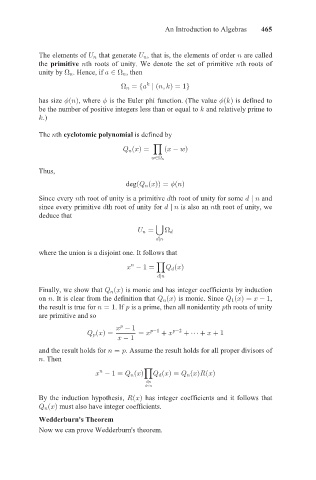Page 481 - Advanced Linear Algebra
P. 481
An Introduction to Algebras 465
The elements of < that generate < , that is, the elements of order are called
the primitive th roots of unity. We denote the set of primitive th roots of
unity by + . Hence, if + , then
+ ~¸ ² Á ³~ ¹
(
has size , where is the Euler phi function. The value ² ³ is defined to
² ³
be the number of positive integers less than or equal to and relatively prime to
.)
The th cyclotomic polynomial is defined by
8²%³ ~ ²% c $³
$+
Thus,
deg²8 ²%³³ ~ ² ³
Since every th root of unity is a primitive th root of unity for some and
since every primitive th root of unity for is also an th root of unity, we
deduce that
<~ +
where the union is a disjoint one. It follows that
%c ~ 8 ²%³
Finally, we show that 8²%³ is monic and has integer coefficients by induction
on . It is clear from the definition that 8 ² % ³ is monic. Since 8 ² % ³ ~ % c ,
the result is true for ~ . If is a prime, then all nonidentity th roots of unity
are primitive and so
%c
8 ² % ³ ~ ~ % c b % c2 b Ä b % b
%c
and the result holds for ~ . Assume the result holds for all proper divisors of
. Then
% c ~ 8 ²%³ 8 ²%³ ~ 8 ²%³9²%³
By the induction hypothesis, 9²%³ has integer coefficients and it follows that
8²%³ must also have integer coefficients.
Wedderburn's Theorem
Now we can prove Wedderburn's theorem.

